Education Reforms in Australia: Funding, Impact and Analysis
VerifiedAdded on 2020/02/24
|5
|1365
|32
Report
AI Summary
This report provides a comprehensive analysis of the recent education reforms in Australia, focusing on the government's proposed changes to higher education funding. The report examines the implications of reduced funding, increased student fees, and adjustments to loan repayment thresholds. It highlights the potential impacts on both domestic and international students, as well as on Australian universities, particularly concerning non-government funding. The analysis includes a discussion of the labor market and its influence on graduates, as well as the government's objectives for transparency and accountability. The report also offers recommendations for policy makers, including adjustments to the labor market structure and a reconsideration of policies affecting international students. The conclusion emphasizes the potential negative consequences of the proposed reforms for students and universities, including the possibility of reduced demand from neighboring countries for Australian higher education opportunities.
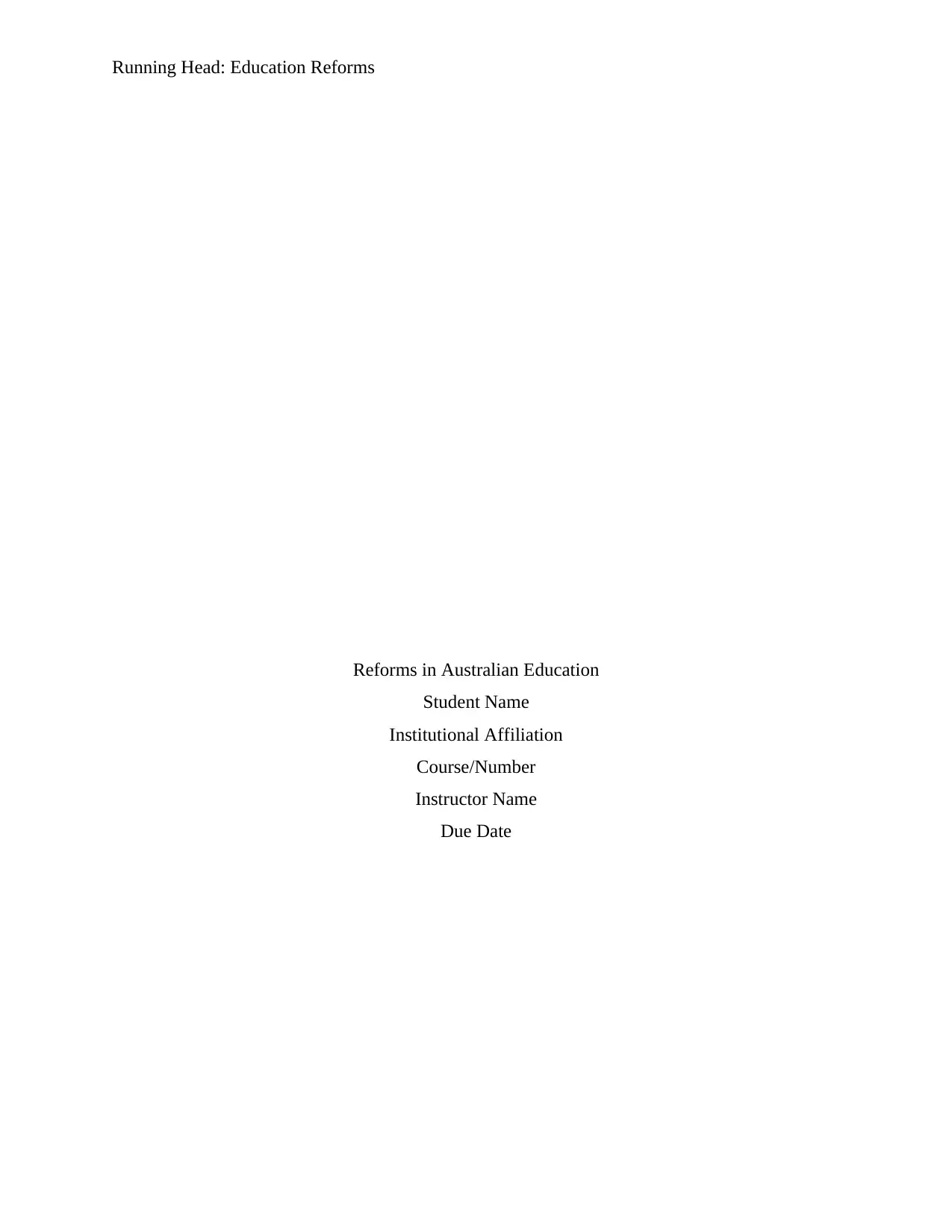
Running Head: Education Reforms
Reforms in Australian Education
Student Name
Institutional Affiliation
Course/Number
Instructor Name
Due Date
Reforms in Australian Education
Student Name
Institutional Affiliation
Course/Number
Instructor Name
Due Date
Paraphrase This Document
Need a fresh take? Get an instant paraphrase of this document with our AI Paraphraser
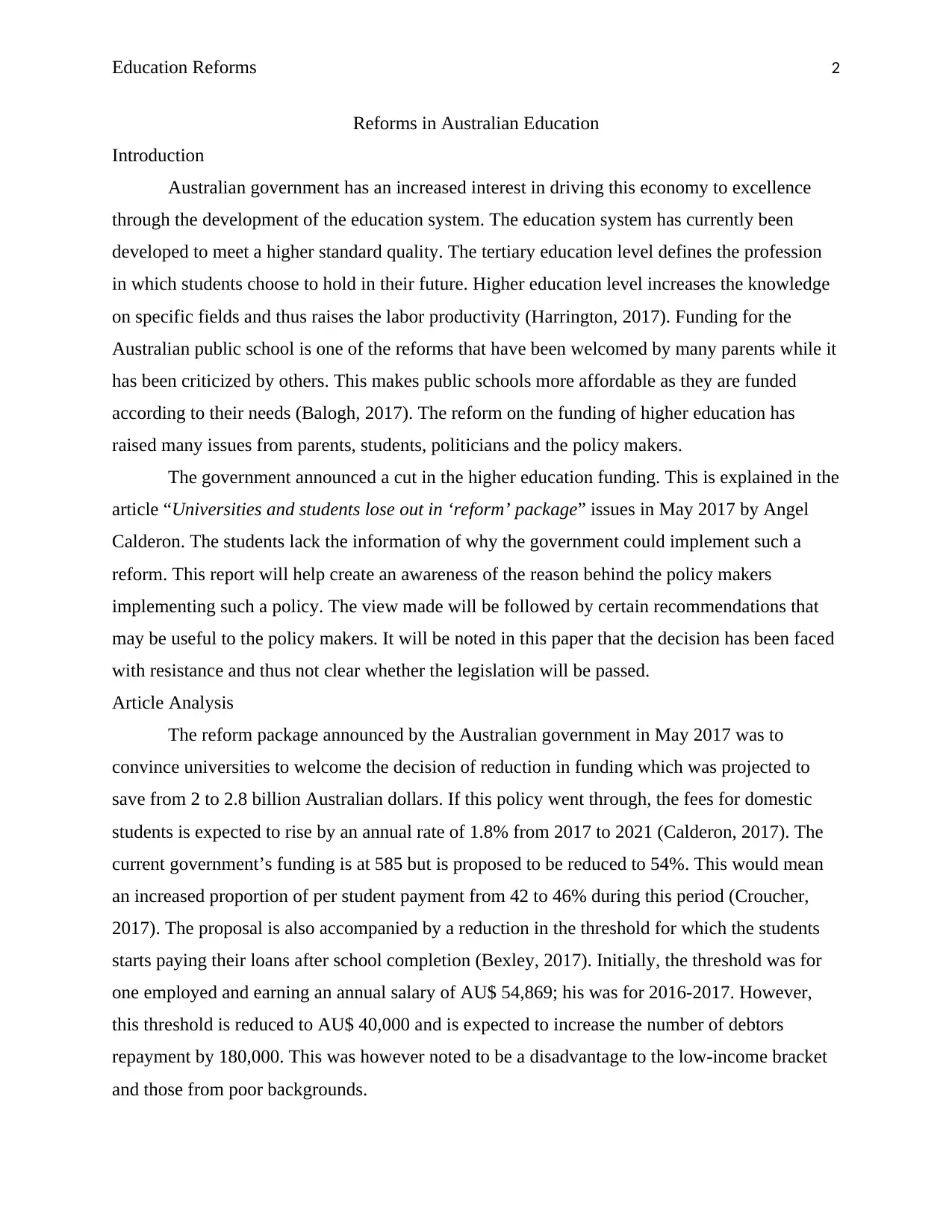
Education Reforms 2
Reforms in Australian Education
Introduction
Australian government has an increased interest in driving this economy to excellence
through the development of the education system. The education system has currently been
developed to meet a higher standard quality. The tertiary education level defines the profession
in which students choose to hold in their future. Higher education level increases the knowledge
on specific fields and thus raises the labor productivity (Harrington, 2017). Funding for the
Australian public school is one of the reforms that have been welcomed by many parents while it
has been criticized by others. This makes public schools more affordable as they are funded
according to their needs (Balogh, 2017). The reform on the funding of higher education has
raised many issues from parents, students, politicians and the policy makers.
The government announced a cut in the higher education funding. This is explained in the
article “Universities and students lose out in ‘reform’ package” issues in May 2017 by Angel
Calderon. The students lack the information of why the government could implement such a
reform. This report will help create an awareness of the reason behind the policy makers
implementing such a policy. The view made will be followed by certain recommendations that
may be useful to the policy makers. It will be noted in this paper that the decision has been faced
with resistance and thus not clear whether the legislation will be passed.
Article Analysis
The reform package announced by the Australian government in May 2017 was to
convince universities to welcome the decision of reduction in funding which was projected to
save from 2 to 2.8 billion Australian dollars. If this policy went through, the fees for domestic
students is expected to rise by an annual rate of 1.8% from 2017 to 2021 (Calderon, 2017). The
current government’s funding is at 585 but is proposed to be reduced to 54%. This would mean
an increased proportion of per student payment from 42 to 46% during this period (Croucher,
2017). The proposal is also accompanied by a reduction in the threshold for which the students
starts paying their loans after school completion (Bexley, 2017). Initially, the threshold was for
one employed and earning an annual salary of AU$ 54,869; his was for 2016-2017. However,
this threshold is reduced to AU$ 40,000 and is expected to increase the number of debtors
repayment by 180,000. This was however noted to be a disadvantage to the low-income bracket
and those from poor backgrounds.
Reforms in Australian Education
Introduction
Australian government has an increased interest in driving this economy to excellence
through the development of the education system. The education system has currently been
developed to meet a higher standard quality. The tertiary education level defines the profession
in which students choose to hold in their future. Higher education level increases the knowledge
on specific fields and thus raises the labor productivity (Harrington, 2017). Funding for the
Australian public school is one of the reforms that have been welcomed by many parents while it
has been criticized by others. This makes public schools more affordable as they are funded
according to their needs (Balogh, 2017). The reform on the funding of higher education has
raised many issues from parents, students, politicians and the policy makers.
The government announced a cut in the higher education funding. This is explained in the
article “Universities and students lose out in ‘reform’ package” issues in May 2017 by Angel
Calderon. The students lack the information of why the government could implement such a
reform. This report will help create an awareness of the reason behind the policy makers
implementing such a policy. The view made will be followed by certain recommendations that
may be useful to the policy makers. It will be noted in this paper that the decision has been faced
with resistance and thus not clear whether the legislation will be passed.
Article Analysis
The reform package announced by the Australian government in May 2017 was to
convince universities to welcome the decision of reduction in funding which was projected to
save from 2 to 2.8 billion Australian dollars. If this policy went through, the fees for domestic
students is expected to rise by an annual rate of 1.8% from 2017 to 2021 (Calderon, 2017). The
current government’s funding is at 585 but is proposed to be reduced to 54%. This would mean
an increased proportion of per student payment from 42 to 46% during this period (Croucher,
2017). The proposal is also accompanied by a reduction in the threshold for which the students
starts paying their loans after school completion (Bexley, 2017). Initially, the threshold was for
one employed and earning an annual salary of AU$ 54,869; his was for 2016-2017. However,
this threshold is reduced to AU$ 40,000 and is expected to increase the number of debtors
repayment by 180,000. This was however noted to be a disadvantage to the low-income bracket
and those from poor backgrounds.
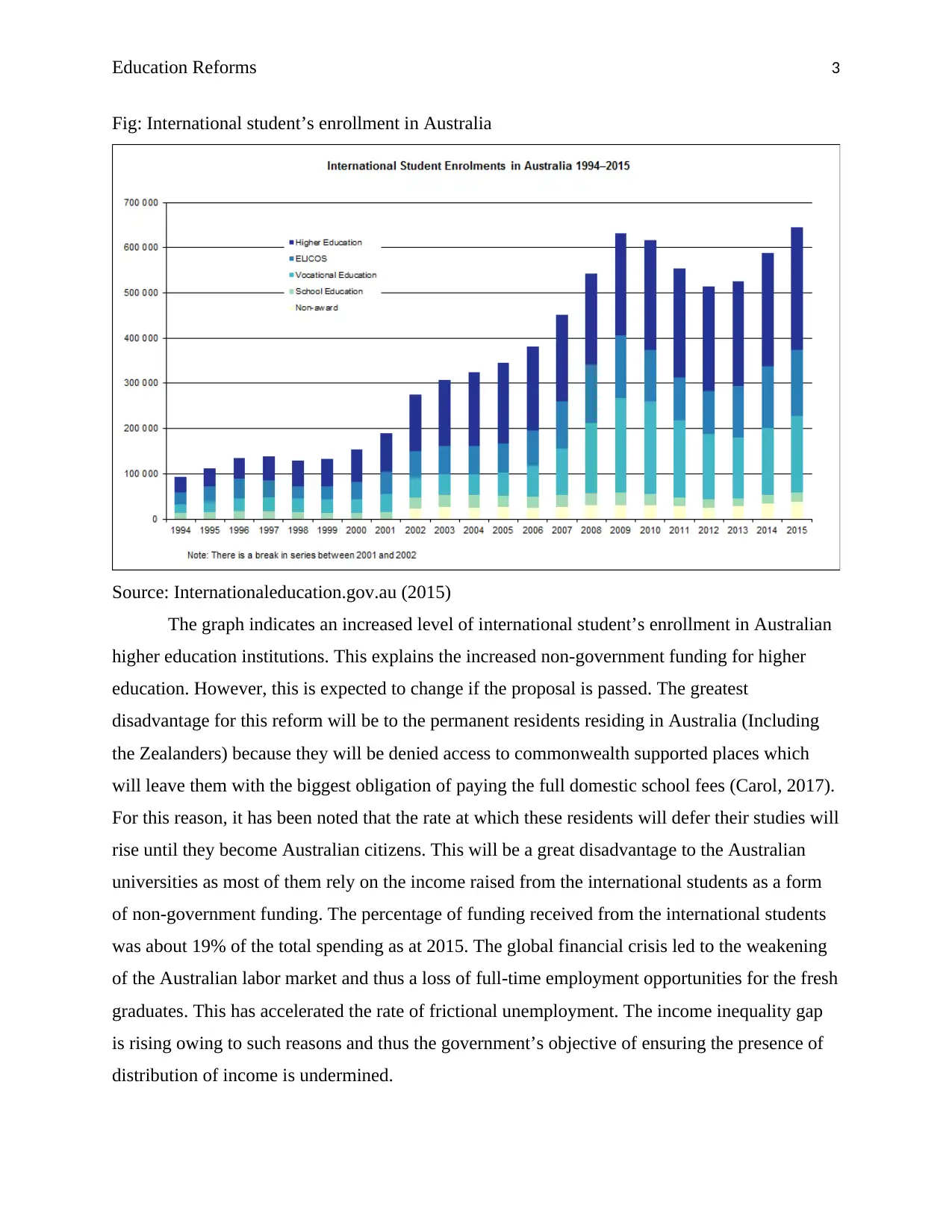
Education Reforms 3
Fig: International student’s enrollment in Australia
Source: Internationaleducation.gov.au (2015)
The graph indicates an increased level of international student’s enrollment in Australian
higher education institutions. This explains the increased non-government funding for higher
education. However, this is expected to change if the proposal is passed. The greatest
disadvantage for this reform will be to the permanent residents residing in Australia (Including
the Zealanders) because they will be denied access to commonwealth supported places which
will leave them with the biggest obligation of paying the full domestic school fees (Carol, 2017).
For this reason, it has been noted that the rate at which these residents will defer their studies will
rise until they become Australian citizens. This will be a great disadvantage to the Australian
universities as most of them rely on the income raised from the international students as a form
of non-government funding. The percentage of funding received from the international students
was about 19% of the total spending as at 2015. The global financial crisis led to the weakening
of the Australian labor market and thus a loss of full-time employment opportunities for the fresh
graduates. This has accelerated the rate of frictional unemployment. The income inequality gap
is rising owing to such reasons and thus the government’s objective of ensuring the presence of
distribution of income is undermined.
Fig: International student’s enrollment in Australia
Source: Internationaleducation.gov.au (2015)
The graph indicates an increased level of international student’s enrollment in Australian
higher education institutions. This explains the increased non-government funding for higher
education. However, this is expected to change if the proposal is passed. The greatest
disadvantage for this reform will be to the permanent residents residing in Australia (Including
the Zealanders) because they will be denied access to commonwealth supported places which
will leave them with the biggest obligation of paying the full domestic school fees (Carol, 2017).
For this reason, it has been noted that the rate at which these residents will defer their studies will
rise until they become Australian citizens. This will be a great disadvantage to the Australian
universities as most of them rely on the income raised from the international students as a form
of non-government funding. The percentage of funding received from the international students
was about 19% of the total spending as at 2015. The global financial crisis led to the weakening
of the Australian labor market and thus a loss of full-time employment opportunities for the fresh
graduates. This has accelerated the rate of frictional unemployment. The income inequality gap
is rising owing to such reasons and thus the government’s objective of ensuring the presence of
distribution of income is undermined.
⊘ This is a preview!⊘
Do you want full access?
Subscribe today to unlock all pages.

Trusted by 1+ million students worldwide
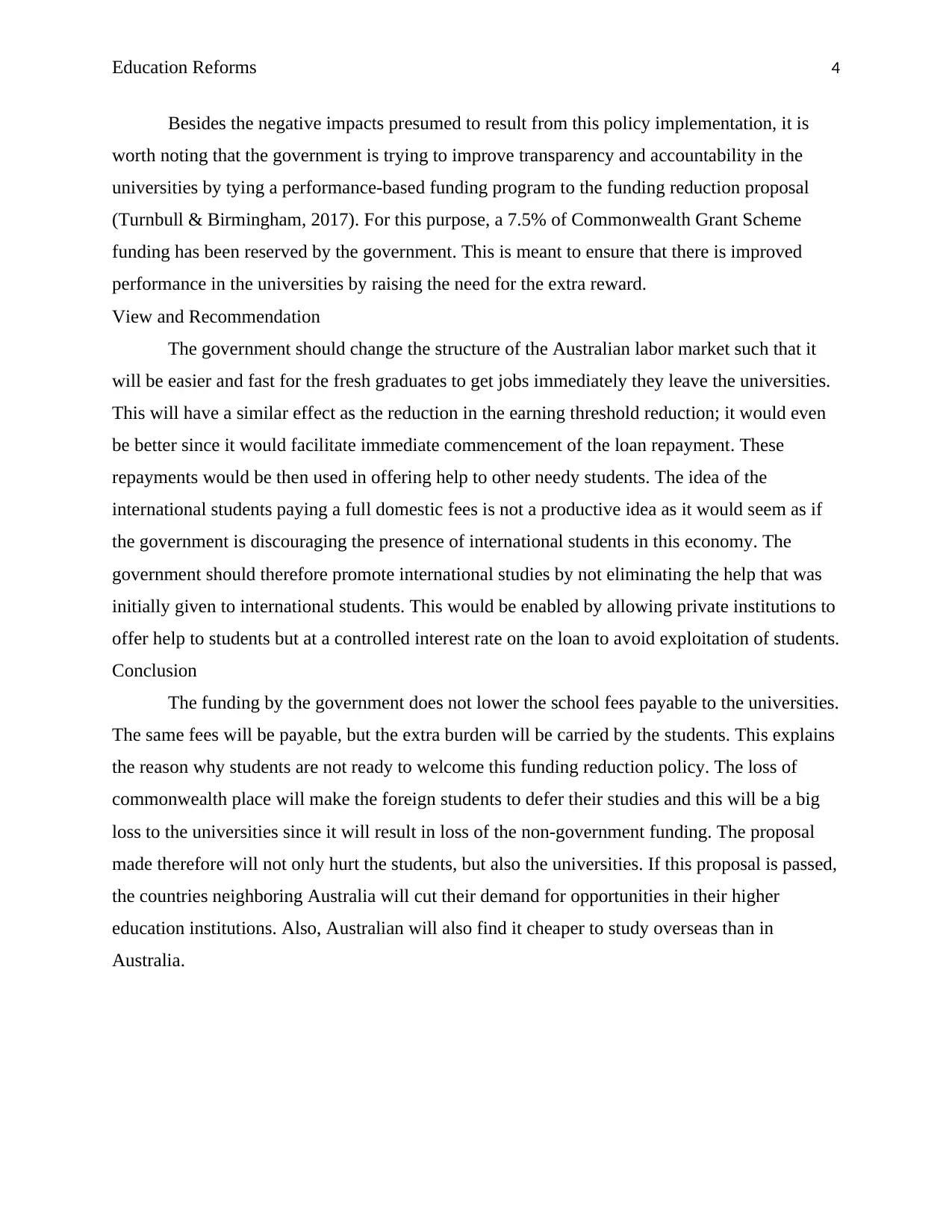
Education Reforms 4
Besides the negative impacts presumed to result from this policy implementation, it is
worth noting that the government is trying to improve transparency and accountability in the
universities by tying a performance-based funding program to the funding reduction proposal
(Turnbull & Birmingham, 2017). For this purpose, a 7.5% of Commonwealth Grant Scheme
funding has been reserved by the government. This is meant to ensure that there is improved
performance in the universities by raising the need for the extra reward.
View and Recommendation
The government should change the structure of the Australian labor market such that it
will be easier and fast for the fresh graduates to get jobs immediately they leave the universities.
This will have a similar effect as the reduction in the earning threshold reduction; it would even
be better since it would facilitate immediate commencement of the loan repayment. These
repayments would be then used in offering help to other needy students. The idea of the
international students paying a full domestic fees is not a productive idea as it would seem as if
the government is discouraging the presence of international students in this economy. The
government should therefore promote international studies by not eliminating the help that was
initially given to international students. This would be enabled by allowing private institutions to
offer help to students but at a controlled interest rate on the loan to avoid exploitation of students.
Conclusion
The funding by the government does not lower the school fees payable to the universities.
The same fees will be payable, but the extra burden will be carried by the students. This explains
the reason why students are not ready to welcome this funding reduction policy. The loss of
commonwealth place will make the foreign students to defer their studies and this will be a big
loss to the universities since it will result in loss of the non-government funding. The proposal
made therefore will not only hurt the students, but also the universities. If this proposal is passed,
the countries neighboring Australia will cut their demand for opportunities in their higher
education institutions. Also, Australian will also find it cheaper to study overseas than in
Australia.
Besides the negative impacts presumed to result from this policy implementation, it is
worth noting that the government is trying to improve transparency and accountability in the
universities by tying a performance-based funding program to the funding reduction proposal
(Turnbull & Birmingham, 2017). For this purpose, a 7.5% of Commonwealth Grant Scheme
funding has been reserved by the government. This is meant to ensure that there is improved
performance in the universities by raising the need for the extra reward.
View and Recommendation
The government should change the structure of the Australian labor market such that it
will be easier and fast for the fresh graduates to get jobs immediately they leave the universities.
This will have a similar effect as the reduction in the earning threshold reduction; it would even
be better since it would facilitate immediate commencement of the loan repayment. These
repayments would be then used in offering help to other needy students. The idea of the
international students paying a full domestic fees is not a productive idea as it would seem as if
the government is discouraging the presence of international students in this economy. The
government should therefore promote international studies by not eliminating the help that was
initially given to international students. This would be enabled by allowing private institutions to
offer help to students but at a controlled interest rate on the loan to avoid exploitation of students.
Conclusion
The funding by the government does not lower the school fees payable to the universities.
The same fees will be payable, but the extra burden will be carried by the students. This explains
the reason why students are not ready to welcome this funding reduction policy. The loss of
commonwealth place will make the foreign students to defer their studies and this will be a big
loss to the universities since it will result in loss of the non-government funding. The proposal
made therefore will not only hurt the students, but also the universities. If this proposal is passed,
the countries neighboring Australia will cut their demand for opportunities in their higher
education institutions. Also, Australian will also find it cheaper to study overseas than in
Australia.
Paraphrase This Document
Need a fresh take? Get an instant paraphrase of this document with our AI Paraphraser
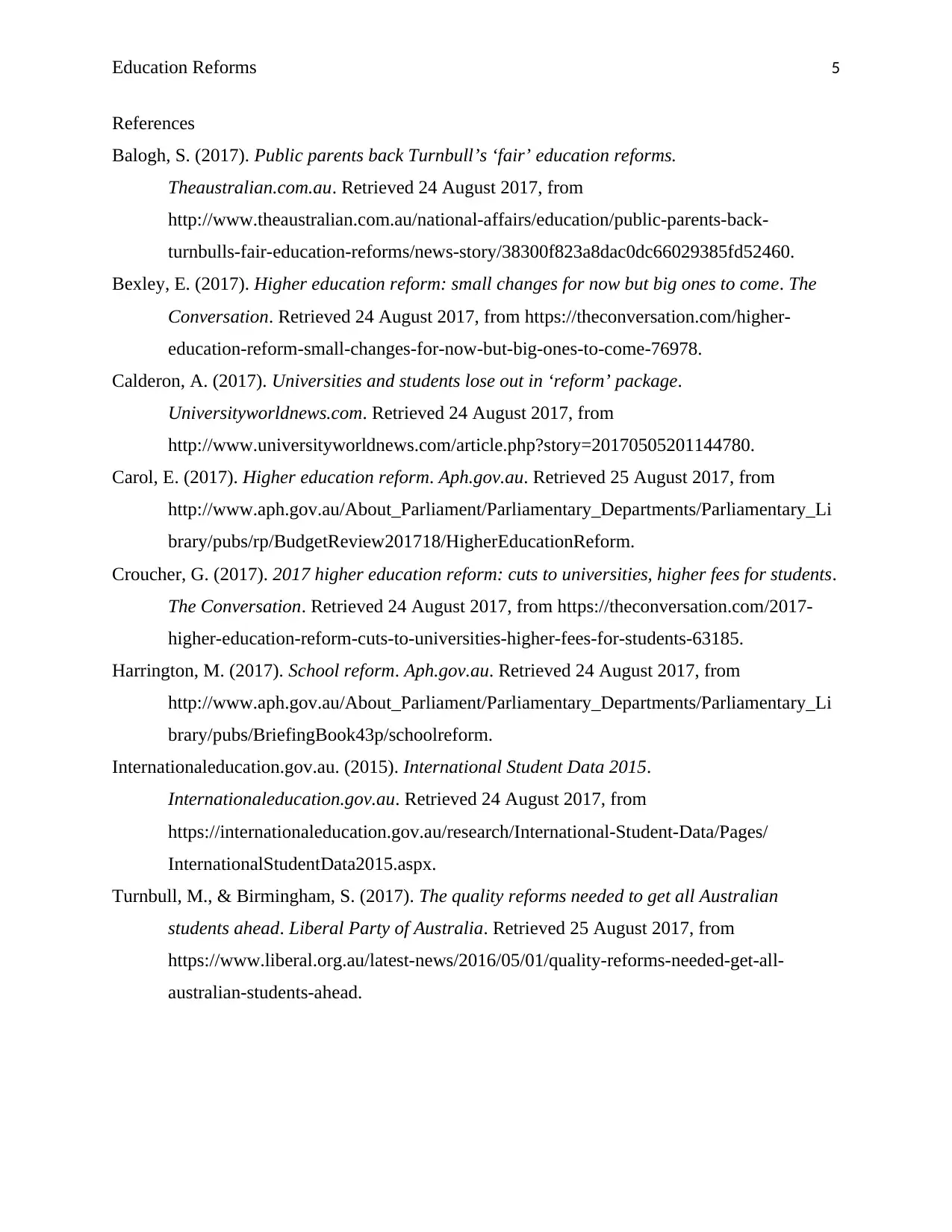
Education Reforms 5
References
Balogh, S. (2017). Public parents back Turnbull’s ‘fair’ education reforms.
Theaustralian.com.au. Retrieved 24 August 2017, from
http://www.theaustralian.com.au/national-affairs/education/public-parents-back-
turnbulls-fair-education-reforms/news-story/38300f823a8dac0dc66029385fd52460.
Bexley, E. (2017). Higher education reform: small changes for now but big ones to come. The
Conversation. Retrieved 24 August 2017, from https://theconversation.com/higher-
education-reform-small-changes-for-now-but-big-ones-to-come-76978.
Calderon, A. (2017). Universities and students lose out in ‘reform’ package.
Universityworldnews.com. Retrieved 24 August 2017, from
http://www.universityworldnews.com/article.php?story=20170505201144780.
Carol, E. (2017). Higher education reform. Aph.gov.au. Retrieved 25 August 2017, from
http://www.aph.gov.au/About_Parliament/Parliamentary_Departments/Parliamentary_Li
brary/pubs/rp/BudgetReview201718/HigherEducationReform.
Croucher, G. (2017). 2017 higher education reform: cuts to universities, higher fees for students.
The Conversation. Retrieved 24 August 2017, from https://theconversation.com/2017-
higher-education-reform-cuts-to-universities-higher-fees-for-students-63185.
Harrington, M. (2017). School reform. Aph.gov.au. Retrieved 24 August 2017, from
http://www.aph.gov.au/About_Parliament/Parliamentary_Departments/Parliamentary_Li
brary/pubs/BriefingBook43p/schoolreform.
Internationaleducation.gov.au. (2015). International Student Data 2015.
Internationaleducation.gov.au. Retrieved 24 August 2017, from
https://internationaleducation.gov.au/research/International-Student-Data/Pages/
InternationalStudentData2015.aspx.
Turnbull, M., & Birmingham, S. (2017). The quality reforms needed to get all Australian
students ahead. Liberal Party of Australia. Retrieved 25 August 2017, from
https://www.liberal.org.au/latest-news/2016/05/01/quality-reforms-needed-get-all-
australian-students-ahead.
References
Balogh, S. (2017). Public parents back Turnbull’s ‘fair’ education reforms.
Theaustralian.com.au. Retrieved 24 August 2017, from
http://www.theaustralian.com.au/national-affairs/education/public-parents-back-
turnbulls-fair-education-reforms/news-story/38300f823a8dac0dc66029385fd52460.
Bexley, E. (2017). Higher education reform: small changes for now but big ones to come. The
Conversation. Retrieved 24 August 2017, from https://theconversation.com/higher-
education-reform-small-changes-for-now-but-big-ones-to-come-76978.
Calderon, A. (2017). Universities and students lose out in ‘reform’ package.
Universityworldnews.com. Retrieved 24 August 2017, from
http://www.universityworldnews.com/article.php?story=20170505201144780.
Carol, E. (2017). Higher education reform. Aph.gov.au. Retrieved 25 August 2017, from
http://www.aph.gov.au/About_Parliament/Parliamentary_Departments/Parliamentary_Li
brary/pubs/rp/BudgetReview201718/HigherEducationReform.
Croucher, G. (2017). 2017 higher education reform: cuts to universities, higher fees for students.
The Conversation. Retrieved 24 August 2017, from https://theconversation.com/2017-
higher-education-reform-cuts-to-universities-higher-fees-for-students-63185.
Harrington, M. (2017). School reform. Aph.gov.au. Retrieved 24 August 2017, from
http://www.aph.gov.au/About_Parliament/Parliamentary_Departments/Parliamentary_Li
brary/pubs/BriefingBook43p/schoolreform.
Internationaleducation.gov.au. (2015). International Student Data 2015.
Internationaleducation.gov.au. Retrieved 24 August 2017, from
https://internationaleducation.gov.au/research/International-Student-Data/Pages/
InternationalStudentData2015.aspx.
Turnbull, M., & Birmingham, S. (2017). The quality reforms needed to get all Australian
students ahead. Liberal Party of Australia. Retrieved 25 August 2017, from
https://www.liberal.org.au/latest-news/2016/05/01/quality-reforms-needed-get-all-
australian-students-ahead.
1 out of 5
Related Documents
Your All-in-One AI-Powered Toolkit for Academic Success.
+13062052269
info@desklib.com
Available 24*7 on WhatsApp / Email
![[object Object]](/_next/static/media/star-bottom.7253800d.svg)
Unlock your academic potential
Copyright © 2020–2025 A2Z Services. All Rights Reserved. Developed and managed by ZUCOL.





